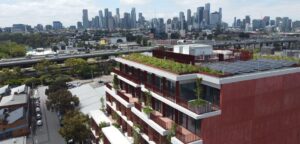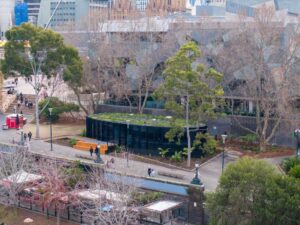
Green roofs and biodiversity: building sustainable cities from the top down
By Michael Casey
Biodiversity is increasingly recognised as a driving force behind many of our urban greening projects worldwide. As cities expand, they face the challenge of preserving and enhancing natural ecosystems, leading to a surge in biodiversity-centred urban planning.
Biodiversity in urban environments contributes to ecosystem services, such as improved air quality, climate regulation, and enhanced human well-being. Greener cities are more resilient to environmental challenges like flooding, heat waves and pollution, while supporting a diverse range of species. Consequently, urban greening strategies, including green roofs, parks, and urban forests, are being developed with a focus on enhancing biodiversity. These projects improve the quality of life for urban residents and create habitats for wildlife, contributing to the overall ecological balance.
With a major focus on new greening projects across Australia, I aim to highlight innovative ways green roofs restore biodiversity to cities that have long been deprived of this crucial life form.

Why is biodiversity so important to our urban development? We need to look no further than the roles it plays from environmental awareness through to the mental and physical wellbeing of the people calling cities home. When biodiversity is included in the designing of cities, we increase environmental awareness in our communities that then leads into a sense of ownership and care. Along with this ownership comes education on why we need to incorporate biodiversity and why it requires protection. The use of green spaces provides us with the diversity of plant species and the many non-human life forms that find protection in these plants. Cities, as we know, have been stripping back any existing biodiversity for many years through their construction methods but innovative ways, as will be discussed in this article, are demonstrating new ways to bring biodiversity back to the places where it once thrived.
Green infrastructure, including roofs, walls, facades, and open landscapes, plays a vital role in supporting diverse plant populations and associated wildlife. Integrating these elements into urban settings offers numerous benefits, not just for human occupants but also for overall ecological health. My experience with green roofs across Melbourne has demonstrated their growing popularity and effectiveness. The following projects highlight how pivotal these are with Melbourne’s ongoing efforts to enhance urban green spaces and biodiversity. Below, we explore three standout projects transforming Melbourne’s skyline into a lush, green canopy.
The biodiversity green roof at Kensington in the north of the city was built on top of a seven-story commercial office space and was designed using the City of Melbourne’s Green Factor Tool (an assessment tool helping professionals design and construct new buildings that are environmentally friendly and include green infrastructure). This biodiversity roof aims to foster a symbiotic relationship between the building occupants and nature, promoting well-being and productivity through immersion in the natural environment while prioritising sustainability in design and operation. This 400m² biodiversity green roof is connected by seven stories of trees and sprawling plants, spanning across each floor of the building. Serving as vital connectors, they facilitate the integration of insects and birds into the roof’s diverse ecosystem, bringing biodiversity to unexpected places. A predominantly native palette was used for this project. This project creates human and social capital through the correct use of space and plant use, along with creating a cooling effect and clean air for occupants of the building. It also creates a relaxed working and learning environment, vital in today’s fast-paced world. Environmental capital is created for the neighbourhood through its connection to the local environment and nearby blue infrastructure, with the design driven by a commitment to enhancing the urban biodiversity and the creation of this much-needed biodiversity corridor linking the green roof to the nearby waterway. This approach aims to contribute positively to urban biodiversity conservation efforts. The success of this roof garden is now being hailed as a major achievement and will be available for industry and academia to research for future projects.

The recently installed green roof on top of the Federation Square community information hub located along the banks of the Yarra River in Melbourne has also provided the cityscape with a beautiful mix of native plants, many endemic to the area, along with a small number of exotic species. The Greenline Project, along the banks of the Yarra will feature five inter-connected precincts – Birrarung Marr, The Falls, River Park, Maritime, and Saltwater Wharf – each celebrating the area’s rich Indigenous history. The initiative aims to create a vibrant, sustainable environment that enhances the health and well-being of residents and visitors, improves the river’s ecological health, and secures the city’s future prosperity. The green roof features a unique mixture of Australian native and endemic plant species, including pre-colonial plants, with a 20% mix of exotic species. This blend was carefully selected to comply with the City of Melbourne’s request for a 90/10 native to exotic plant mix. The strict planting palette was adjusted following expert advice from the design team to an 80/20 mix to allow better establishment rates of the native species. The exotic plants provide initial protection for the untested native plants, and will be gradually phased out as the native species establish themselves.
As a show of true commitment and to further enhance Melbourne’s reputation as a green city, a bold new initiative at 1 Treasury Place will see a new green rooftop transforming the top end of town into an urban oasis. The $2.5 million project, funded by the Melbourne City Council, Victorian Government, and not-for-profit Hort Innovation, aims to create a vibrant, plant-filled rooftop that models future green urban infrastructure. This project reflects Melbourne’s broader commitment to sustainable urban development and its ambition to mitigate climate change through green innovations. Green roofs, like the one recently built for Treasury Place, have been proven to reduce greenhouse gas emissions, lower energy consumption, enhance stormwater retention, and combat heat waves. Additionally, they provide well-documented benefits for mental and physical well-being and act as a reminder for all of this state’s decision-makers that the future of our cities is green. They just need to now look out their office windows and witness first-hand the softening effect plants have on our built environment. This project will serve as a research hub to explore the design and feasibility of expanding green infrastructure across the city. It also connects to the Indigenous legacy of caring for the country, recognising the value of plant life and natural ecosystems to the well-being of people and the environment.
Green roofs and other forms of green infrastructure are being designed and constructed across Australian cities. We hope that recent projects by the team at Evergreen Infrastructure will serve as proof of their suitability for our environment when thoughtfully designed. The success of these projects is due to the collaboration of various professional disciplines involved in the design and planning process, ensuring all design and construction considerations are addressed. We sincerely thank the design professionals, academics, plant specialists, and building experts who contributed to making these three examples enduring assets for the City of Melbourne and its residents.
All images supplied by Michael Casey
Michael Casey
Director of Evergreen Infrastructure, Consultant / Advisor to the green infrastructure industry
On the Technical Panel for the AIPH World Green Cities Awards 2024
E: michael@evergreeninfrastructure.com.au
